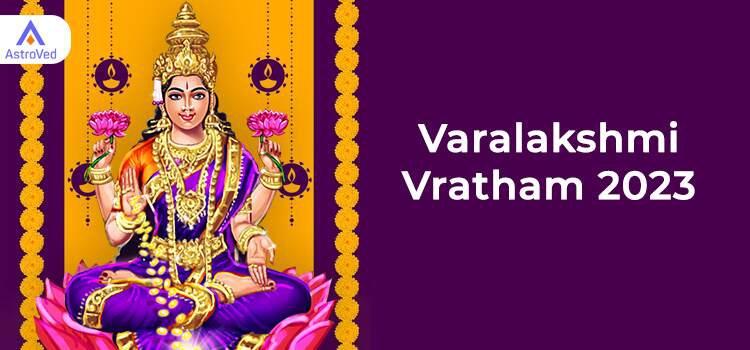Varalakshmi Vratham 2023
Goddess Varalakshmi is a very auspicious form of Mata Lakshmi. ‘Varalakshmi’ comes from two Sanskrit words. ‘Vara’ means ‘ boon,’ and ‘Lakshmi’ means ‘wealth’. Supposedly, Goddess Varalakshmi, when pleased, gives her devotees the boons they seek. Varalakshmi Mata is also called ‘Varamahalakshmi’.
Varalakshmi Vratham is on the Friday before Full Moon, or Purnima, in Shravana month (July-Aug). Varalakshmi Vratham 2023 is on 25 August.
Varalakshmi Vratham
VaralakshmiVrat or Varalakshmi Nombu festival occurs in the month of Shravan (July – August). Varalakshmi Vrata is on the 2nd Friday of Shravan or an afternoon before the Full Moon (Purnima). Observing a fast and performing Varalakshmi Pooja is said to please Lakshmi and helps one gain the blessings of Ashtalakshmi or 8 forms of Lakshmi.
These 8 forms are:
- Adi Lakshmi/Mahalakshmi - Goddess of spiritual wealth and inner conscience.
- Dhana Lakshmi - Goddess of Wealth
- Dhanya Lakshmi- Goddess of food grains
- Gaja Lakshmi- Goddess who gives farm animals/ prosperity and abundance
- Santana Lakshmi- Goddess who bestows offspring
- Dhairya Lakshmi- Goddess of courage and valor
- Vijaya Lakshmi- Goddess of Victory
- Vidya Lakshmi- Goddess of Knowledge and Arts
Worshipping Varalakshmi is like worshipping all the above forms of Lakshmi.

Varalaxmi Vrat Katha/Story
Once there was a town named Kundina, which was part of the Vidarbha Kingdom. In the city lived a pious and devout woman, Charumathi, along with her husband and family.
She would worship Lakshmi regularly. On seeing her devotion, Goddess Adilakshmi was pleased and visited Charumathi in her dreams. She told her to observe the Varalakshmi Vratham with devotion so that her wishes would come true. Charumathi awoke from her sleep and told her husband about her dream. Soon, all the neighbors came to know about it. They, too, wanted to be part of the Pooja. So, the next day, Charumathi and her neighbors (married women) awoke early, took bath, and made preparations for the Pooja. During the Pooja, Charumathi also recited the Sloka given below:
Varalaxmi Vrat Katha/Story
Once there was a town named Kundina, which was part of the Vidarbha Kingdom. In the city lived a pious and devout woman, Charumathi, along with her husband and family.
She would worship Lakshmi regularly. On seeing her devotion, Goddess Adilakshmi was pleased and visited Charumathi in her dreams. She told her to observe the Varalakshmi Vratham with devotion so that her wishes would come true. Charumathi awoke from her sleep and told her husband about her dream. Soon, all the neighbors came to know about it. They, too, wanted to be part of the Pooja. So, the next day, Charumathi and her neighbors (married women) awoke early, took bath, and made preparations for the Pooja.
After reciting the Sloka, she tied the 9 threads referred to as Thoranam on her wrist and offered Naivedyam to Goddess Varalakshmi. At each stage of the Pooja, the goddess rewarded her and the other women with wealth in one form or the other. By the end of the Pooja, all of them had been blessed with abundant wealth.
After reciting the Sloka, she tied the 9 threads referred to as Thoranam on her wrist and offered Naivedyam to Goddess Varalakshmi. At each stage of the Pooja, the goddess rewarded her and the other women with wealth in one form or the other. By the end of the Pooja, all of them had been blessed with abundant wealth.
When the Pooja ended, Charumathi offered Thamboolam to the Brahmin priests. She also gave Prasad to her family members.
Since then, Hindu women in South India have made it a point to perform the Varalakshmi Vratham and Pooja every year for the well-being of their husband and family.
Importance of Varalakshmi Vratham and Pooja
The Varalakshmi Vratham and Pooja are very popular in the South Indian states of Andhra Pradesh, Tamilnadu, and Karnataka. It is not as popular in North Indian states, with the exception of Maharashtra and Orissa.
Sometimes, newly married women or childless women also pray to the goddess to bless them with progeny.
Varalakshmi Pooja Ritual
Pooja Samagri
- Face of the goddess (Available readymade in the market)
- Kalash
- Chandan (Sandal paste)
- Akshata (rice grain covered with turmeric)
- Rice flour & colors - for drawing Kolam/rangoli
- Kumkum
- Turmeric powder
- Banana leaves
- Lotus Flower
- Mango Leaves
- Few Coconuts
- A big, wooden plank called Peeta or Thambaalam
- Raw Rice grains
- Devi Vastra
- Devi Abhushan
- Flowers and garland
- Betel leaves
- Betel nut
- Banana
- Fruits (seasonal)
- Milk
- Dry fruits & nuts
- Panchamrit comprising dry fruits, nuts, jaggery, and ghee
- Scented water (consisting of cardamom, saffron, cloves, edible camphor, and mace) to fill the Kalash.
- Thoram (A sacred thread comprising 9 strings and 9 knots smeared with turmeric powder to be tied on the wrist)
- Pongunool (A thread smeared with turmeric powder and worn on the neck)
- Mahalakshmistothram
- Neivedyam
- Takeaway gift for the women who attend the Pooja. This is called Thamboolam, and it includes Banana, Nuts, Coconut, Betel leaves, Thread smeared in turmeric, a blouse piece, and 1 rupee coin
- Plastic cups and bowls to distribute Prasadam
How to Perform Varalakshmi Pooja
The preparations for the Varalakshmi Pooja begin on Thursday afternoon itself, that is, the day before the Pooja. Women wake up early on Thursday morning and keep all the Pooja vessels beside the Kalash (pot). They pour oil in the lamps, make Thoram and PonguNool along with Kumkum, and set up the Pooja plate.
Varalakshmi Vratham and Pooja Procedure
- On Friday morning, arise early, take bath, and wear silk saree and gold jewelry.
- Avoid food until the Valakshmi Pooja ends (elderly women or ladies having health issues can have fruits and milk).
- Draw a Kolam/rangoli with rice flour and place the Peeta over the Kolam.
- Keep a banana leaf on the Peeta and place a handful of rice grains on the banana leaf. Fill the Kalash with aromatic water, along with the coconut and betel leaves, on the rice grains.
- Now, use a new and shiny blouse piece to cover the coconut like a cone.
- Apply turmeric to the face of the coconut and adorn it with ornaments like a nose ring, ornamental eyes, and a necklace. Readymade faces of the goddess are also available in the market.
- Tie a Pongunool around the neck of the coconut or the face of the goddess. The Pongu represents the Mangalsutra.
- Apply Chandan and Kumkum tikas on the forehead, palms, and legs of the goddess.
- Now begin the Pooja by lighting a ghee diya.
- Worship Goddess Lakshmi by meditating on energized Lakshmi Yantras.
- While meditating, chant her seed mantra: ॥ Om Hreem Shreem Lakshmibhayo Namah॥
- Chant Lakshmi Mantra on the Lotus Seed bead.
It is also advisable to perform a Mahalakshmi Pooja with the help of a Brahmin priest.
- The Pooja comprises Kalash Sthapana
- Panchang Sthapana (Gauri Ganesh, Punyavachan, ShodashMatrika, Navgraha, Sarvotabhadra),
- 64 Yogini Pooja
- Shetrapal Pooja
- Swasti Vachan
- Sankalpa, Ganesh Pooja and Abishek
- Navgraha Pooja and 108 chants of each planetary Mantra
- Invocation of major Gods and Goddesses in the Kalash
- Lakshmi idol Abishek and Pooja
- Lakshmi Yantra Pooja
- Recitation of Lakshmi Suktam,
- Lakshmi Stotram Mantra, recitation of Kanakdhara Stotra, and Lakshmi Mantra Japa
- Lakshmi Homa
- Aarti and Pushpaanjali
- You can wear Seven Mukhi Rudraksha beads as it is dominated by Goddess Lakshmi. Wearing them on this day purifies your inner self, boosts your willpower, and attracts wealth.
- Start the Pooja by worshipping Ganesha first. Chant His Mantra and Stotram.
- After the Ganesha Pooja, take a few akshata (rice grains) and flowers in your right palm and chant the Avahanam Sloka.
- Think of Lakshmi with devotion and offer the flowers and akshata to the pot or the Kalash.
- After this, perform the Thorakrandhi Pooja/Nombu Saradu Pooja/Thoram Pooja.
- Lastly, perform Mangala Aarathi by offering various kinds of Neivedyam to the Nonbu Saradu.
- Tie the thoram (turmeric-covered thread) on your right wrist and put the Pongunool on your neck.
- Mix the Kumkum and turmeric in water in a vessel and sing the Mangala Aarti.




















